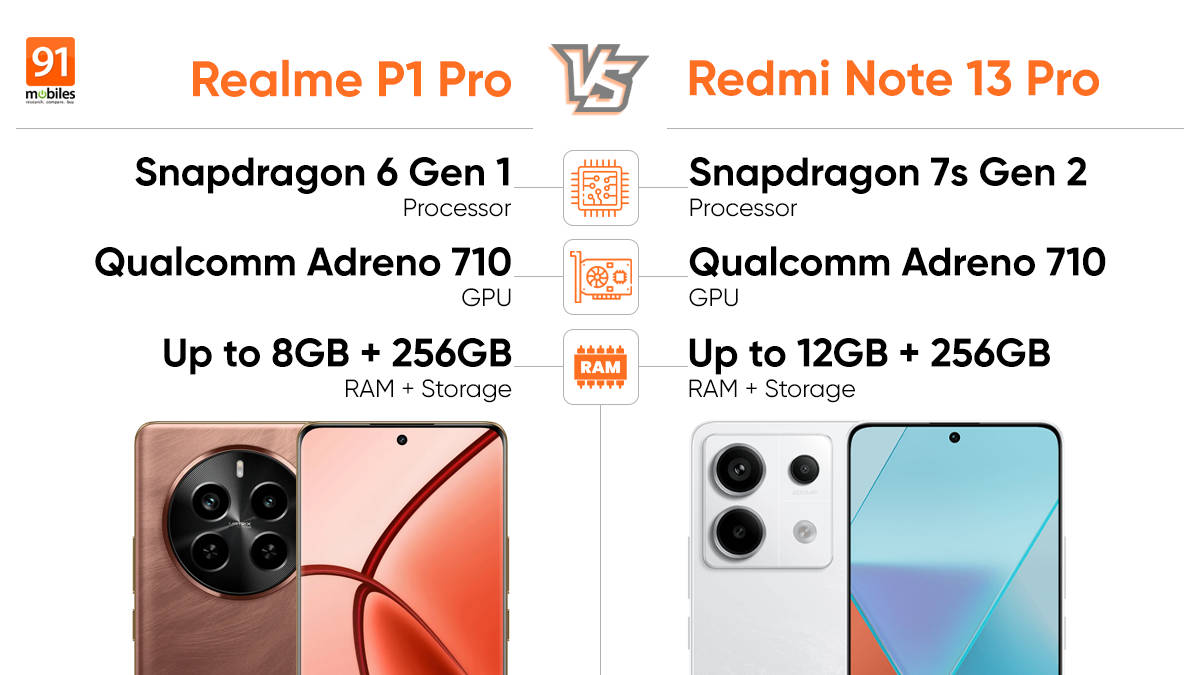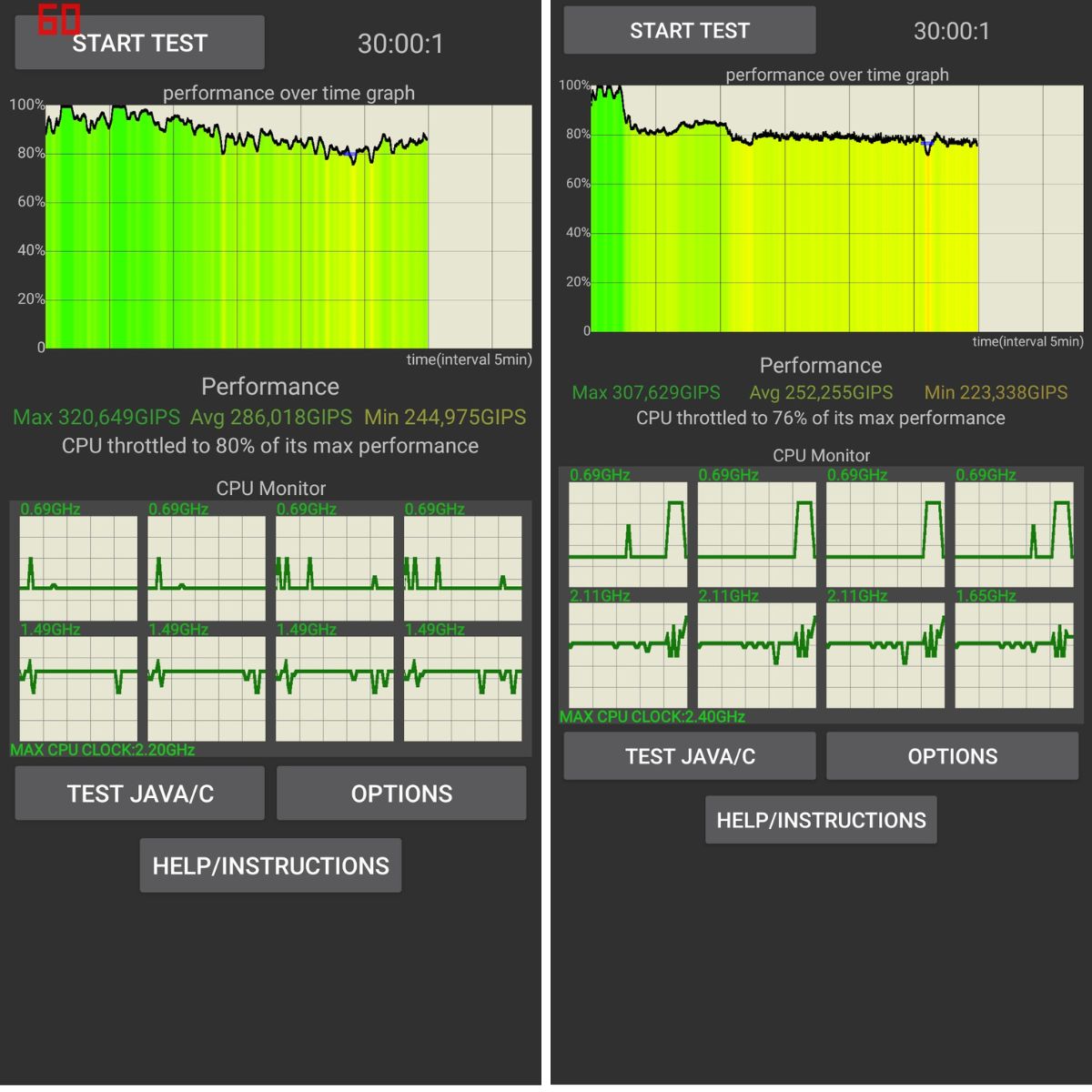
Realme’s Realme P1 Pro (review) is the company’s latest attempt to disrupt India’s most competitive smartphone segment. The brand continues to launch dependable devices in the sub-Rs 30K range under its number series (Realme 11, Realme 12, etc.) and the Narzo lineup. Although its new P-series is relatively more affordable, it places a strong emphasis on performance.
Starting at Rs 20,999, the Realme P1 Pro takes on offerings from established giants, including Xiaomi. The Realme P1 Pro particularly fares directly against Xiaomi’s Redmi Note 13 Pro (review), which costs marginally higher at Rs 24,999 and is equally popular in the segment with some cutting-edge features.
How do the two phones perform based on benchmarks and gaming? Here’s a comparison.
Table of Contents
Specifications
| Smartphone | Realme P1 Pro | Redmi Note 13 Pro |
| Processor | Qualcomm Snapdragon 6 Gen 1 SoC | Qualcomm Snapdragon 7s Gen 2 SoC |
| GPU | Qualcomm Adreno 710 GPU | Qualcomm Adreno 710 GPU |
| Memory | Up to 8GB of RAM and 256GB of storage | Up to 12GB of RAM and 256GB of storage |
Geekbench
To be clear, the Redmi Note 13 Pro we’re comparing offers 8GB of RAM and 128GB of storage. The Realme P1 Pro offers the same RAM capacity but with an increased 256GB storage for Rs 21,999.

In Geekbench’s single and multi-core tests, which essentially evaluate a smartphone’s CPU capabilities under heavy load, Redmi Note 13 Pro achieved slighly higher scores than Realme P1 Pro. The scores indicate Redmi Note 13 Pro’s superiority in basic tasks such as browsing or app load and heavy tasks, including game or editing.
Winner: Redmi Note 13 Pro
AnTuTu
Notably, the Realme P1 Pro achieved a higher score in the AnTuTu test, which evaluates processing power, GPU, storage, and more. The difference isn’t night and day though.

During the test, both smartphones used up 6 percent of their battery. However, the Redmi Note 13 Pro got warmer than the Realme P1 Pro during the AnTuTu test.
Winner: Realme P1 Pro
CPU Throttle
The CPU Throttle test also points out Realme P1 Pro’s efficiency under heavy stress. The Redmi Note 13 Pro exhibited 76 percent stability under peak performance. On the other hand, the Realme P1 Pro was more stable at 80 percent.

We ran the test by modifying the settings to 50 threads for a duration of 30 minutes.
Winner: Realme P1 Pro
Gaming
While both smartphones don’t essentially lean towards gaming, you can run some moderately demanding titles, including Call of Duty and Battleground Mobile India. There’s support for high graphics at up to 60fps on Call of Duty.

The Realme P1 Pro outperformed the Redmi Note 13 Pro as it consumed less battery (8 percent) and remained cooler after 30 minutes of gaming. Additionally, in BGMI, the Realme smartphone also supports Ultra HDR graphics. Again, the Realme P1 Pro performed more efficiently. It consumed less battery and managed heat better than the Redmi Note 13 Pro.
Winner: Realme P1 Pro
Verdict
The Realme P1 Pro was more power efficient than the Redmi Note 13 Pro in the benchmarks and our gaming tests. Both smartphones can easily handle daily tasks as well as some gaming, and differences in real life are difficult to distinguish. Even the Geekbench and AnTuTu indicate a similar performance more or less.
In that case, if you’re planning to buy either of the two smartphones, here are some points to keep in mind:
- The Redmi Note 13 Pro supports faster charging speeds. With the bundled 67W charger, the phone attained 100 percent charge (from 20 percent) in 46 minutes. The Realme P1 Pro took roughly 50 minutes with the bundled 45W charger.
- The Redmi Note 13 Pro comes with a 200MP primary camera and an 8MP ultra-wide angle camera. The Realme P1 Pro carries a 50MP AI camera and an 8MP ultra-wide camera.
- Both phones need to improve the software experience as several pre-installed apps make the UI cluttered. They are also promised three years of major Android OS updates.












